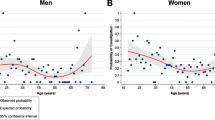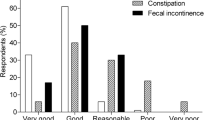Abstract
The purpose of this study was to estimate the prevalence of self-reported, ROME II–defined constipation and determine the average defecation frequency and stool types in the Iranian population. A self-reported questionnaire was distributed to 1045 participants, including items intended to identify the presence of ROME II–defined functional constipation and the dominant form of stool based on the Bristol Scale. The weekly mean bowel movement frequency in men and women was 12.5 ± 7.3 and 13.8 ± 8.0, respectively (p < 0.05). A total of 87.4% of participants had a stool frequency of between 3 and 21 times per week. The prevalence of functional constipation was 32.9%, whereas only 9.6% of participants reported themselves to be constipated (level of agreement κ = 0.21, 95% confidence interval: 0.15 to 0.27). Soft or formed stool was reported in 75.7% of individuals. Functional constipation is common in the Iranian population, but its diagnosis could not rely on subjective patient complaints. Despite a higher average of bowel frequency, the previously reported normal range of defecation frequency can be applied for the Iranian population.
Similar content being viewed by others
References
Talley NJ (2004) Definitions, epidemiology, and impact of chronic constipation. Rev Gastroenterol Disord 4(Suppl 2):S3–S10
Talley NJ (1999) Irritable bowel syndrome: definition, diagnosis and epidemiology. Baillieres Best Pract Res Clin Gastroenterol 13(3):371–384
Glia A, Lindberg G (1997) Quality of life in patients with different types of functional constipation. Scand J Gastroenterol 32(11):1083–1089
Thompson WG, Longstreth GF, Drossman DA, Heaton KW, Irvine EJ, Muller-Lissner SA (1999) Functional bowel disorders and functional abdominal pain. Gut 45(Suppl 2):II43–II47
Pare P, Ferrazzi S, Thompson WG, Irvine EJ, Rance L (2001) An epidemiological survey of constipation in canada: definitions, rates, demographics, and predictors of health care seeking. Am J Gastroenterol 96(11):3130–3137
Seven Point Bristol Stool Form Scale. Available at: http://www.aboutconstipation.org
Zuckerman MJ, Guerra LG, Drossman DA, Foland JA, Gregory GG (1995) Comparison of bowel patterns in Hispanics and non-Hispanic whites. Dig Dis Sci 40(8):1763–1769
Roig Vila JV, Garcia Garcia A, Flors Alandi C, Castells Ferrer P, Lledo Matoses S (1993) The defecation habits in a normal working population. Rev Esp Enferm Dig 84(4):224–230
Chen LY, Ho KY, Phua KH (2000). Normal bowel habits and prevalence of functional bowel disorders in Singaporean adults—findings from a community based study in Bishan. Community Medicine GI Study Group. Singapore Med J 41(6):255–258
Fang X, Lu S, Pan G (2001) An epidemiologic study of bowel habit in adult non-patient population in Beijing area. Zhonghua Yi Xue Za Zhi 81(21):1287–1290
Walter S, Hallbook O, Gotthard R, Bergmark M, Sjodahl R (2002) A population-based study on bowel habits in a Swedish community: prevalence of faecal incontinence and constipation. Scand J Gastroenterol 37(8):911–916
Everhart JE, Go VL, Johannes RS, Fitzsimmons SC, Roth HP, White LR (1989) A longitudinal survey of self-reported bowel habits in the United States. Dig Dis Sci 34(8):1153–1562
Higgins PD, Johanson JF (2004) Epidemiology of constipation in North America: a systematic review. Am J Gastroenterol 99(4):750–759
Talley NJ, Weaver AL, Zinsmeister AR, Melton LJ 3rd (1993) Functional constipation and outlet delay: a population-based study. Gastroenterology. 105(3):781–790
Harari D, Gurwitz JH, Avorn J, Choodnovskiy I, Minaker KL (1994) Constipation: assessment and management in an institutionalized elderly population. J Am Geriatr Soc 42(9):947–952
Heaton KW, Radvan J, Cripps H, Mountford RA, Braddon FE, Hughes AO (1992) Defecation frequency and timing, and stool form in the general population: a prospective study. Gut 33(6):818–824
Stewart WF, Liberman JN, Sandler RS, Woods MS, Stemhagen A, Chee E, Lipton RB, Farup CE (1999) Epidemiology of constipation (EPOC) study in the United States: relation of clinical subtypes to sociodemographic features. Am J Gastroenterol 94(12):3530–3540
Author information
Authors and Affiliations
Corresponding author
Rights and permissions
About this article
Cite this article
Adibi, P., Behzad, E., Pirzadeh, S. et al. Bowel Habit Reference Values and Abnormalities in Young Iranian Healthy Adults. Dig Dis Sci 52, 1810–1813 (2007). https://doi.org/10.1007/s10620-006-9509-2
Received:
Accepted:
Published:
Issue Date:
DOI: https://doi.org/10.1007/s10620-006-9509-2




